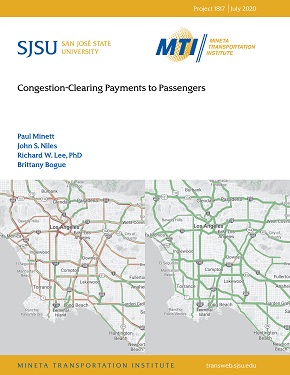- 408-924-7560
- mineta-institute@sjsu.edu
- Donate
Congestion-Clearing Payments to Passengers
Peak period motor vehicle traffic volume congests roads all over the world. This project hypothesizes implementing congestion- clearing payments to passengers as a permanent congestion-management solution. Ongoing congestion-free travel would be achieved by removing existing congestion, and absorbing (re)generated demand, at costs that would be expected to increase as the total number of travelers increases over time. The project develops a comprehensive, step-by-step methodology to calculate the benefits and costs of paying for drivers to become passengers at a congestion-clearing level and to maintain this level over time. The method is derived from the literature, analysis by the project team, and development of a case study. The case study, based on a long-standing bottleneck location in California, enabled the project team to think through the real challenges of developing and evaluating such a solution.
The project finds that the conceptual underpinning of the solution is sound. Based on a survey, the case study finds that there is a level of payment that could clear congestion and maintain free-flow for twenty years, with benefits that outweigh costs on a net present value basis by about four to one—though calibration is required. After the initial reward clears the queue at the bottleneck, a significant intra-peak demand shift would occur as existing and new travelers depart home at times that are more to their liking, potentially causing the queue to re-form. A second incentive manages time of travel, rewarding people for traveling as passengers earlier (or later) than the preferred high demand peak-of-the-peak. In the case study, the high proportion of people who say they will only drive alone would eventually result in some periods of single-occupant-vehicle-only traffic during peak, which is an unintended and undesirable consequence. For the case study route, a limit on single-occupant-vehicle travel during the peak- of-the-peak would ensure that high-occupancy-vehicle travel is given preference and would reduce the overall cost of the solution.
For the case study, the cost of the congestion-clearing payments-to-passengers solution on a net present value basis is within the estimated range of costs of the alternative of expanding the facility, and the benefits are expected to be greater than for facility expansion. Congestion-clearing payments to passengers can be implemented much sooner and will have greater positive long-term economic impacts. Facility expansion would provide lower and shorter-term benefits and would be expected to return to congested conditions within a year.
The project team proposes a pilot project on the case study route to test and calibrate the solution, as well as recommending development of further case study routes to find out how different routes vary and determine the causes of any variations.
See project webinar
Take a look at the coverage on this project from the Half Moon Bay Review and the AASHTO Journal.
PAUL MINETT, MBA
Paul Minett is a researcher and business strategy consultant based in Auckland, New Zealand. He is managing director of Trip Convergence Ltd., established in 2004 to leverage insights into transportation and which led to a patent award in 2007, and chief executive of Strategic Lift Ltd., a strategy consultancy providing advice to small and medium sized businesses, mostly in New Zealand. He is also a Research Associate with the Mineta Transportation Institute. He earned a Master of Business Administration from the University of Auckland in 1993. He has over 15 years of research interest in methods to increase carpooling to reduce traffic and has completed several related research projects. He is a co-founder of both the Ridesharing Institute and the Ridesharing subcommittee of the Transportation Research Board.
JOHN S. NILES
John Niles is Founder and President of Global Telematics, a policy research consultancy based in Seattle focused on designing policies and actions for transportation improvement. As a Research Associate at Mineta Transportation Institute, he has led team studies on transit-oriented development, urban freight mobility planning, bus rapid transit, and park-and- ride productivity analysis. He is co-author of the textbook The End of Driving: Transportation Systems and Public Policy Planning for Autonomous Vehicles (Elsevier, 2018), as well as many technical reports and articles. He earned his MS at Carnegie Mellon University and his SB at Massachusetts Institute of Technology.
RICHARD W. LEE, PhD, AICP
Richard Lee is a lecturer in the Urban and Regional Planning Department at San José State University and has been a Research Associate with the Mineta Transportation Institute (MTI) for over 20 years. He has led MTI studies in general plans and sustainability, airport planning, and sustainability indicators for transportation. Dr. Lee is also a Principal with Transportation Choices for Sustainable Communities, a non-profit research and policy institute. He has over 30 years of experience as a transportation consultant and academic. His consulting experience includes management of regional transportation plans, corridor studies, general plan studies, high-speed rail and transit projects, as well as a wide variety of traffic impact, travel demand management, and transportation policy studies. Much of his recent work focuses on quantitative analysis of the efficacy of various policies in promoting transit and alternative modes. Dr. Lee earned his master’s degrees in Civil Engineering (1984) and City and Regional Planning (1985) and his PhD in City and Regional Planning (1995), all from the University of California at Berkeley. In 2009–2010 he was the Visiting Practitioner and Researcher at UC Davis’ Sustainable Transportation Center. He has taught transportation planning and conducted transportation research projects at several universities, including Massey University in New Zealand, UCLA, Cal Poly San Luis Obispo, UC Berkeley, and San José State University.
BRITTANY BOGUE
Brittany Bogue is a graduate student in Urban and Regional Planning at San Jose State University. Her research interests broadly include sustainable transportation and mobility justice.
-
Contact Us
San José State University One Washington Square, San Jose, CA 95192 Phone: 408-924-7560 Email: mineta-institute@sjsu.edu






